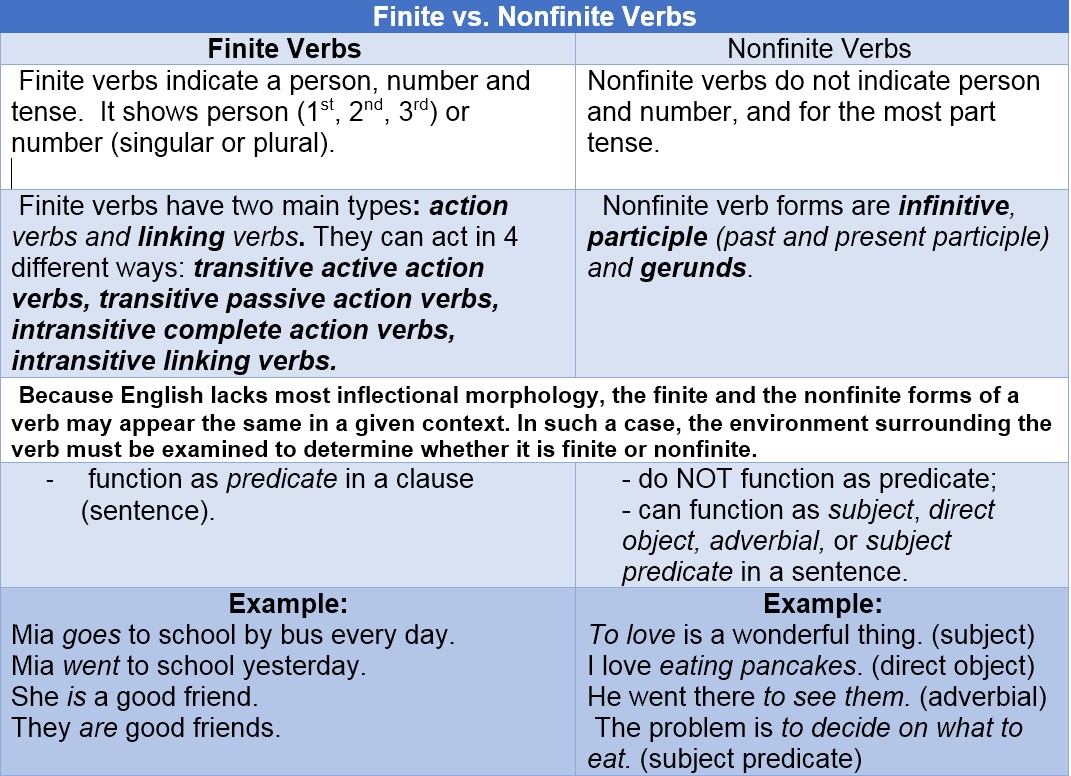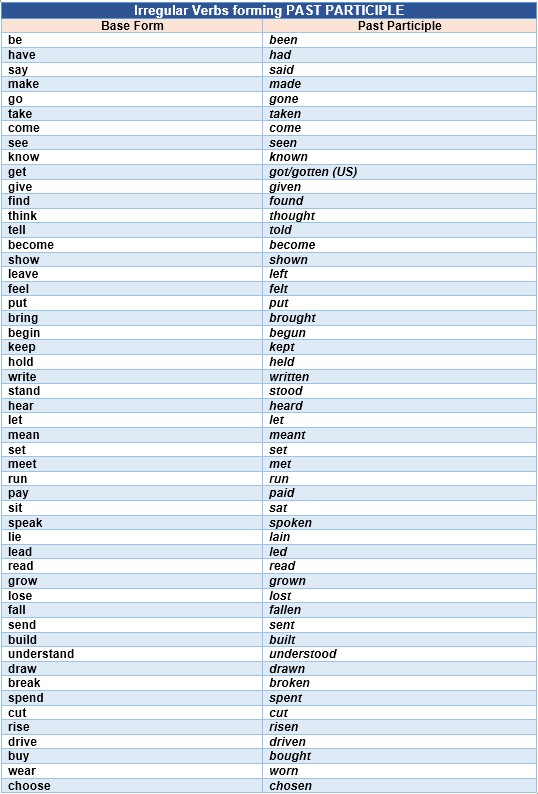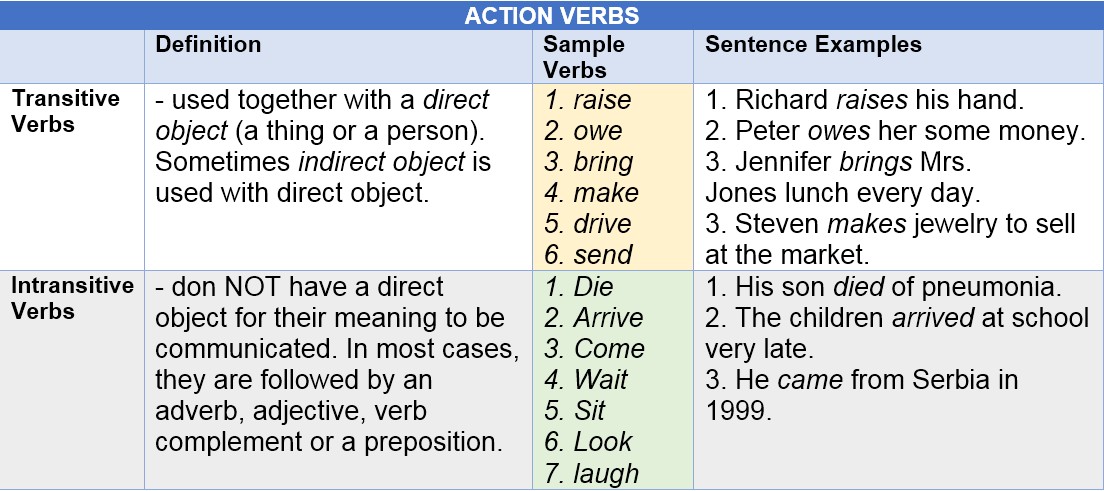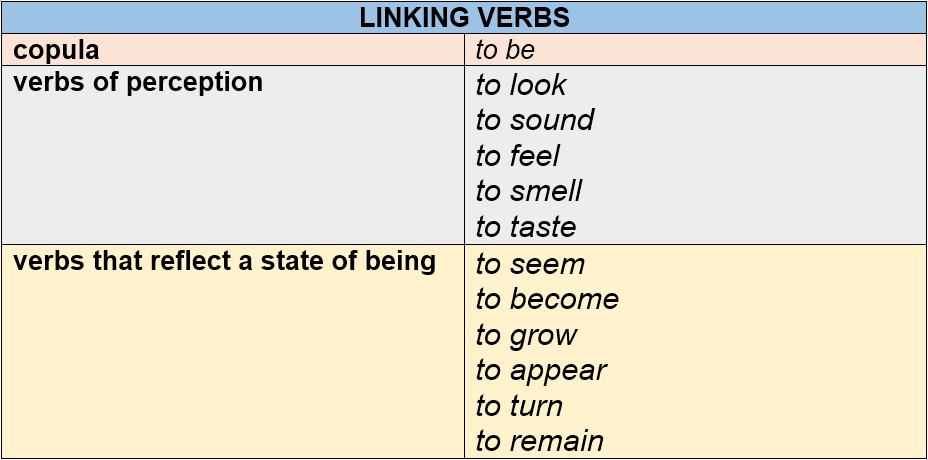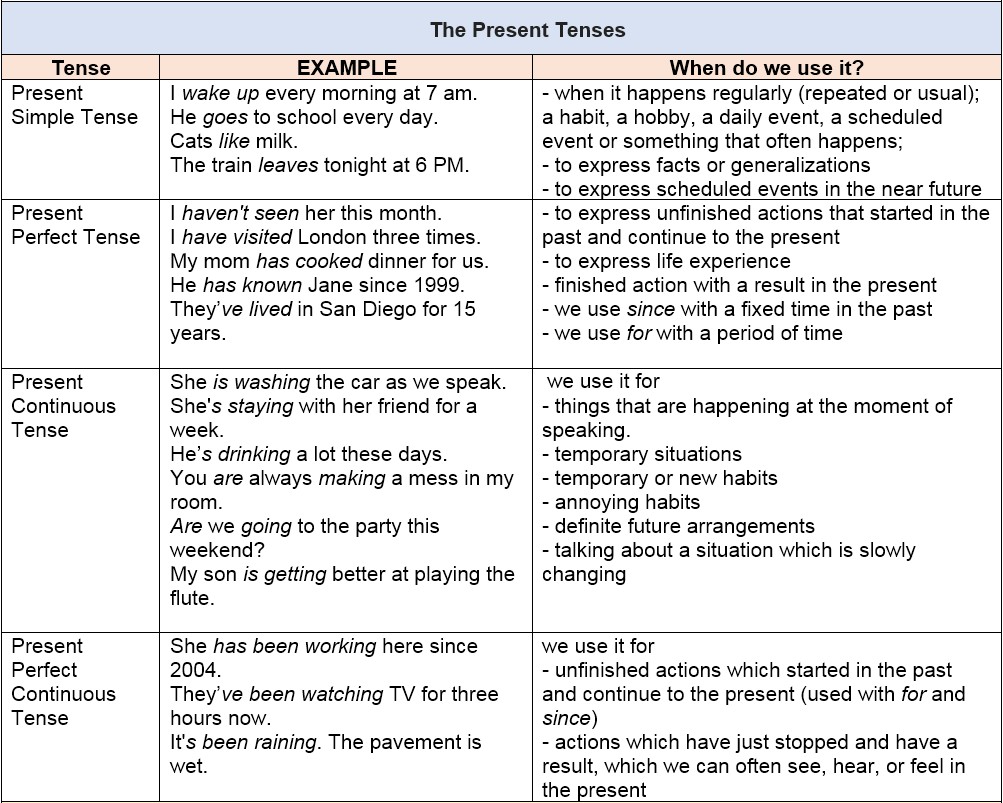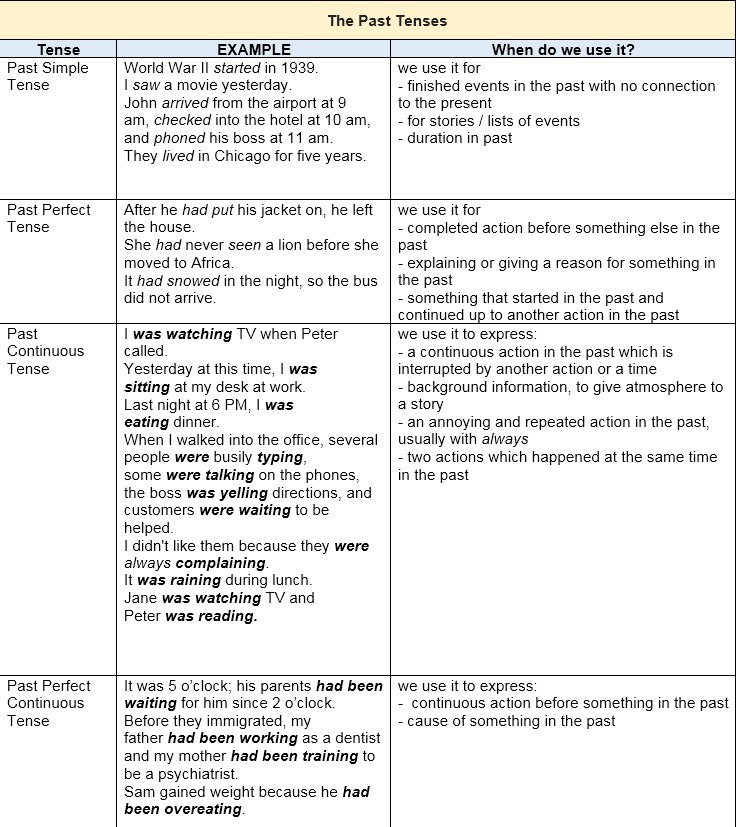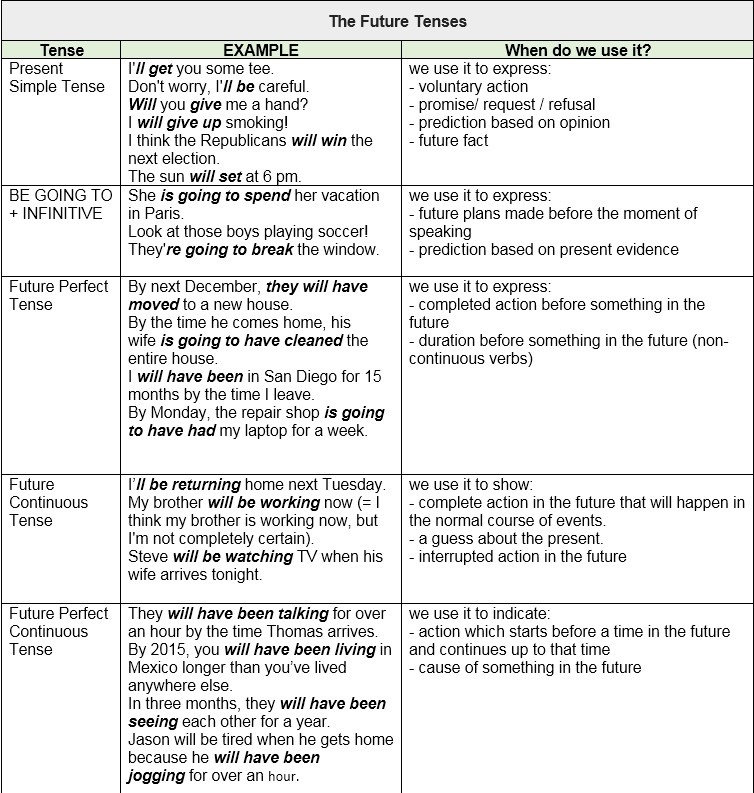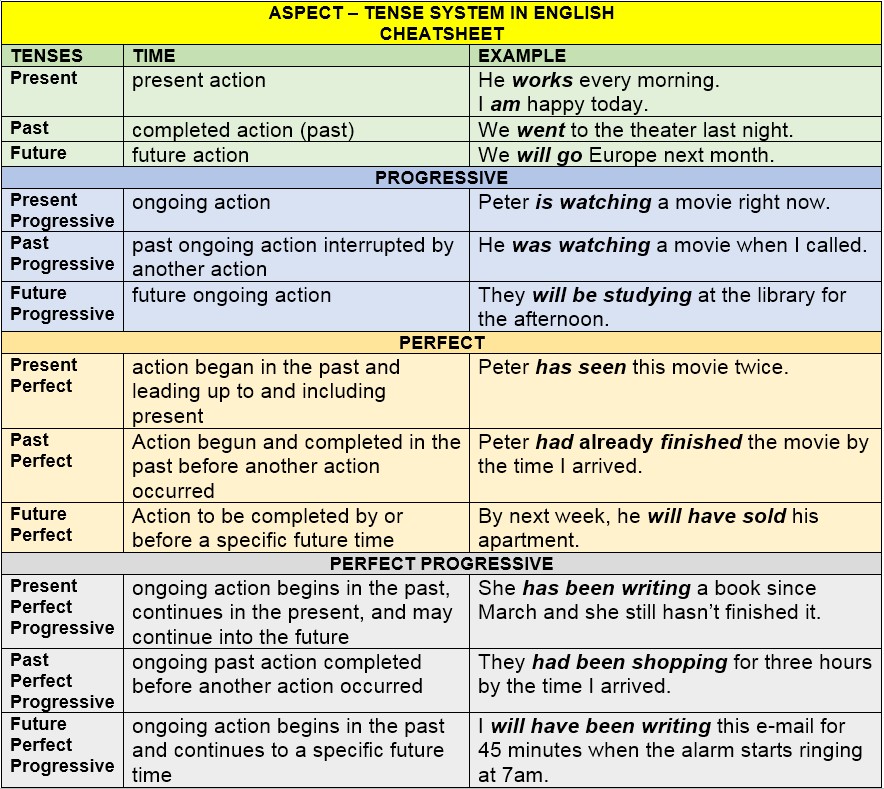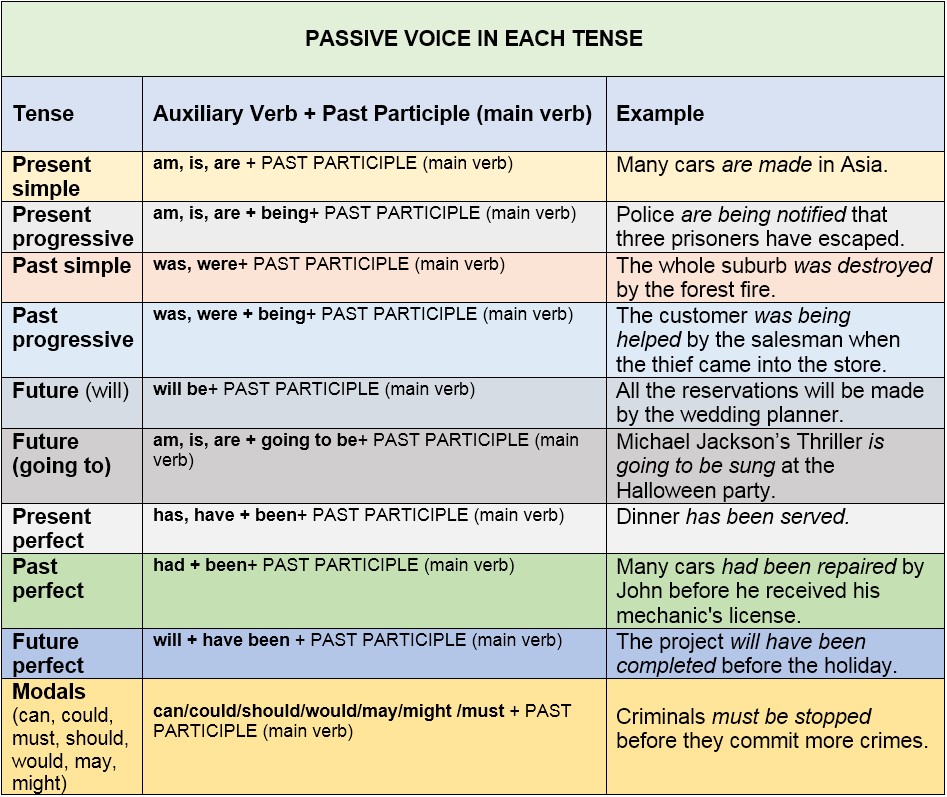Irregular Verbs forming PAST PARTICIPLE
VERBS AND GRAMMATICAL CATEGORIES (number, person, voice, mood, and tense)
Download
Basic English Grammar Book for Students PDF File
DEFINITION: Verbs are words that express action or a state of being in the sentence. They tell us something about the subject.
TYPES:
We can classify verbs into FINITE (MAIN) and NON-FINITE verbs
Non-Finite verbs
Nonfinite verbs are verbs that are not inflected by grammatical tense, person or number. This means they do not show tense, person or number. They sometimes are called verbals, but that term has traditionally applied only to participles and gerunds.
Typically, nonfinite verbs in English are:
- infinitive forms with and without to(e.g. to go, go),
- participle forms: -edforms for past participle (g. gone) and –ing forms for present participle (e.g. going)
- gerunds: –ingforms (e.g. going).
A nonfinite verb (an infinitive or participle) does not show a distinction in tense and can occur on its own only in a dependent phrase or clause.
EXAMPLE:
While walking to school, she spotted a mocking jay.
She tiptoed round the house so as not to wake anyone.
You need to paint the whole cupboard, starting from the bottom.
Because English lacks most inflectional morphology, the finite and the nonfinite forms of a verb may appear the same in a given context. In such a case, the environment surrounding the verb must be examined to determine whether it is finite or nonfinite.
INFINITIVES
DEFINITION: The infinitive is the basic dictionary form of a verb when used non-finitely, with or without the particle to. Infinitives can be used as a noun or an adjective in a sentence.
FORM: The form with particle to is called the full infinitive or to-infinitive: to + base (e.g. to go, to run, to smile). The form without to is called the bare infinitive (e.g. go, run, smile).
EXAMPLE:
To love is the most important thing in the world. (to love is used as a noun, that is, it functions as the subject of the sentence.)
Peter wants to swim. (to swim is used as a noun, that is, it functions as object of the verb wants.)
Oh boy, he has stories to tell!? (to tell modifies the noun stories; therefore, it is used as an adjective.)
PARTICIPLES
DEFINITION: A participle is a form of a verb that is used in a sentence to modify a noun, noun phrase, verb, or verb phrase. It plays a role similar to an adjective or adverb. It is one of the types of nonfinite verb forms.
There are two participles in English:
- Present participle, also sometimes called active, imperfect, or progressive participle, takes the suffix (ending) –ing. Present participle is identical in form to gerund (e.g. doing, writing, putting, going, …).
- Past participle, also sometimes called passive or perfect participle, is identical to the past tense form (ending in -ed) in the case of regular verbs, but takes various forms in the case of irregular verbs, such as done, written, put, gone, etc.
FORMING PRESENT PARTICIPLE:
base form of the verb + -ing
The following rules are used to form present participle:
- If a monosyllabic (one syllable) verb ends in consonant, having consonant+ vowel + consonant, then we double the final consonant and add –ing.
EXAMPLE:
hop – hopping
beg – begging
clap – clapping
- If a verb has more than one syllable and ends in consonant, having consonant+ vowel + consonant, we double the final consonant before -ing only if the final syllable is stressed.
EXAMPLE:
occur – occurring begin – beginning
admit – admitting refer – referring
- When a verb ends in -ic, we add -k before the suffix –ing.
EXAMPLE:
picnic – picnicking panic – panicking
- When a verb ends with silent -e, the silent -e is dropped before the suffix –ing.
EXAMPLE:
close – closing move – moving
live – living have – having
- When a verb ends with -e which is not silent, the final –e is not dropped before the ending –
EXAMPLE:
be – being see – seeing
- When a verb ends with –ie, the –ie is becomes –y before the suffix –ing.
EXAMPLE:
die – dying lie – lying
FORMING PAST PARTICIPLE:
base form of the regular verb + –ed
Regular verbs form past participle by adding the suffix –ed to its base form. The following rules should be applied to create past participle of regular verbs:
- When the verb ends in -y preceded by a consonant, –y changes to -iafter adding the suffix -ed.
EXAMPLE:
study – studied hurry – hurried
apply – applied worry – worried
try – tried marry – married
cry – cried tidy – tidied
busy – busied carry – carried
- When the verb ends in a vowel -e, we add -d to form past participle.
EXAMPLE:
live – lived dance – danced
hope – hoped love – loved
chase – chased smoke – smoked
improve – improved confuse – confused
move – moved phone – phoned
care – cared shave – shaved
- when a monosyllabic (one syllable) verb ends with a constant preceded by a vowel having consonant + vowel + consonant pattern, we double the final consonant before the suffix -ed.
EXAMPLE:
stop – stopped plan – planned
drop – dropped ban – banned
rob – robbed crop – cropped
step – stepped split – splitted
- In a polysyllabic verb (more than one syllable), we double the final consonant when adding the suffix –ed only if the final syllable is stressed.
EXAMPLE:
permit – permitted admit – admitted
prefer – preferred regret – regretted
- When the final syllable of the verb is not stressed, we do not double the final consonant before the suffix –ed.
EXAMPLE:
discover – discovered remember – remembered
visit – visited recover – recovered
listen – listened develop – developed
In British English, the verbs that end in -l double the final consonant before the suffix –ed regardless of the stress.
EXAMPLE:
travel – travelled cancel – cancelled
- When the verb ends in two consonants (-st-, -rt-, -ck-, -sk-, -rn-, -lk-), we do not double the final consonant before the suffix –ed.
EXAMPLE:
post – posted trust – trusted
start – started port – ported
kick – kicked knock – knocked
ask – asked mask – masked
warn – warned turn – turned
walk – walked talk – talked
- If the verb ends with the following pattern vowel+vowel+consonant, we do not double the final consonant when adding the suffix –ed.
EXAMPLE:
boil – boiled exploit – exploited
need – needed explain – explained
shout – shouted found – founded
want – wanted cook – cooked
Irregular verbs form past participle irregularly. Unlike regular English past participles, irregular past participles do not follow any real pattern.
The table below contains the most common irregular verbs in the English language and their past participle forms.
Irregular Verbs forming PAST PARTICIPLE
There are three types of verbs: action verbs, linking verbs, and helping verbs. Action verbs are words that express action (give, eat, walk, etc.) or possession (have, own, etc.). Action verbs can be either transitive or intransitive.
Finite Verbs
DEFINITION: Finite (main) verbs are verbs that have a definite relation with the subject. The finite verb can be the main verb of a clause or sentence. They agree with the noun (subject) in person and number. Finite verbs represent an essential part of a sentence. No finite verb, no sentence!
EXAMPLE:
She goes to school. (3rd person singular)
I go to school. (1st person singular)
They go to school. (3rd person plural)
Finite verbs express tense (when?). They can show indicative or subjunctive mood, and active or passive voice. A finite verb can occur on its own in a main clause. Thus, there are different grammatical categories indicated in the form of the finite verb in English:
- Person: first person, second person or third person.
- Mood: imperative, indicative, or subjunctive
- Voice: active voice, passive voice
- Number: singular number, or plural number.
- Aspect: perfect, progressive (continuous)
- Tense: past tense, present tense or future tense
EXAMPLE:
I wish I were the President of the United States of America. (subjunctive)
I am a student. (indicative, active, present tense)
He bought a house. (indicative, active, past tense)
The store was robbed. (indicative, passive, past tense)
There are three types of verbs: ACTION verbs, LINKING verbs and AUXILIARY (helping) verbs. Action verbs and linking verbs are main verbs. Auxiliary (helping) verbs accompany main verbs to indicate tense, voice, mood, and number.
Action Verbs
DEFINITION: Action verbs express action that the subject carries out. They are expressing action, something that a person, animal, force of nature, or thing can do.
TYPES: Most of the action verbs are categorized as transitive or intransitive.
A transitive verb always has a noun that receives the action of the verb, called the direct object. Sometimes it has an indirect object, which names the object to whom or for whom the action was done.
EXAMPLE:
Jennifer brings Mrs. Jones lunch every day. (Mrs. Jones is the indirect object of verb brings, while lunch is direct object, and Jennifer is the subject)
An intransitive verb does not have a direct or indirect object. Although an intransitive verb may be followed by an adverb or adverbial phrase, there is no object to receive its action.
EXAMPLE:
His son died of pneumonia. (Verb died is followed by preposition of, that is, by prepositional phrase of pneumonia.)
Linking Verbs
DEFINITION: Linking verbs express a state of being and connect subjects to predicates, describing or renaming the subjects. A linking verb is a verb that describes the subject. It connects a subject to its complement.
Linking verbs include copulas such as the English verb to be and its various forms, verbs of perception such as to look, to sound, to feel, to smell, or to taste, and some other verbs that reflect a state of being, such as to seem, to become, to grow, to appear, to turn, or to remain.
EXAMPLE:
John is in love with her.
In the 1990s, Angelina Jolie became a popular actress. (The verb, became, links the subject, Angelina Jolie, to its complement, a popular actress.)
Pizza tastes delicious.
Auxiliary Verbs
DEFINITION: An auxiliary verb (also known as a helping verb) determines the tense, voice, mood, and number of another verb (known as the main or lexical verb) in a verb phrase. In English, a lexical verb (also known as main verb) is any verb that is not an auxiliary verb. The lexical verb conveys a real meaning of the verb phrase.
The primary auxiliaries are the various forms of be, have, and do. The modal auxiliaries include can, could, may, must, should, will, and would.
Auxiliary verbs help main verbs in
- forming the passive, e.g. The man was taken to the hospital.
- expressing the continuity (progressive) aspect, e.g. The boy is running.
- expressing the perfect (completed) aspect, e.g. The rain has stopped.
- providing a dummy verb where a negative or interrogative sentence is to be made using a particular tense, e.g. I don’t like it. or Do you like it?
Modal auxiliary verbs add meaning like:
- ability
- possibility
- permission
- command
- habitual action…
EXAMPLE:
John might have spilled the chocolate milkshake. (might have – auxiliary verb, spilled – main verb)
Sean is watching TV now. (is – auxiliary verb, watching – main verb)
You should see a doctor as soon as possible. (should – auxiliary, see – main verb)
VERBS SUMMARY
- There are three categories of verbs: action verbs, linking verbs and auxiliary verbs.
- Only action and linking verbs can be main verbs in a verb phrase.
- A main verb can be the only verb in a sentence.
- Auxiliary verbs help action and linking verbs express mood, tense, voice, and number, hence the name helping verbs.
- An auxiliary verb and a main verb together make a verb phrase.
VERBS AND GRAMMATICAL CATEGORIES
(number, person, voice, mood, and tense)
Finite verbs express different grammatical categories: number, person, voice, mood aspect, and tense.
NUMBER shows whether the verb refers to singular (one item) or plural (two and more items).
PERSON shows which person or thing does the action. For example, we know if it is first person – I or we, second person – you, or third person – he, she, it, or they).
EXAMPLE:
I am at school. (first person singular)
She likes music. (third person singular)
John doesn’t believe in superstitions. (third person singular)
They play soccer every Thursday. (third person plural)
TENSE helps us express time. Verbs come in three tenses: past, present, future.
The past is used to describe things that have already happened (e.g. earlier in the day, yesterday, last week, three years ago). The present tense is used to describe things that are happening right now, or things that are continuous. The future tense describes things that have yet to happen (e.g. later, tomorrow, next week, next year, three years from now).
ASPECT is a grammatical category that expresses how an action, event, or state, denoted by a verb, extends over time.
Thus, in English tense-aspect system offers:
The Present Tenses
Simple present
Present perfect
Present continuous
Present perfect continuous
The Past Tenses
Simple past
Past perfect
Past continuous
Past perfect continuous
The Future Tenses
Simple Future
Future perfect
Future continuous
Future perfect continuous
The table below describes the Aspect – Tense system in English:
VOICE of a verb refers to passive or active state of the verb.
In the active voice, the subject and verb relationship is straightforward. The subject is the doer of the action.
EXAMPLE:
Janet is a teacher.
She loves teaching mathematics.
The children have lunch at twelve o’clock.
In the passive voice, the subject of the sentence is not the doer of the action. The subject is acted upon by some other agent or by something unnamed. The passive voice is used when we want to emphasize the action (the verb) and the object of a sentence rather than subject. This means that the subject is either less important than the action itself or that we do not know who or what the subject is.
EXAMPLE:
PASSIVE: My laptop was stolen. (My laptop – subject of passive but object in active sentence, was stolen – passive form of the verb)
ACTIVE: Someone stole my laptop. (Someone – subject, stole – active form of the verb, my laptop – object)
Fifty innocent people were killed in the bomb explosion.
PASSIVE: The chicken hawk was killed by Tim.
ACTIVE: Tim killed the chicken hawk.
When we know who the subject is, we put the subject at the end of the passive sentence. In that case, this subject is called an agent.
EXAMPLE:
Romeo and Juliet was written by William Shakespeare. (passive; William Shakespeare is an agent)
William Shakespeare wrote Romeo and Juliet. (active; William Shakespeare is a subject)
Only transitive verbs (those that take objects) can be transformed into passive constructions. Verbs that have no object (that is, no one to “receive” the action) cannot be put into passive. These verbs include arrive, come, go, sleep, die, exist, live, have, and so on.
FORMATION: We form passive voice with AUXILIARY VERB TO BE and PAST PARTICIPLE of the main verb.
FORMING PASSIVE VOICE:
Mood (imperative, indicative, and subjunctive) indicates the manner in which an action or condition is expressed.
Mood of the verb tells us how the speaker feels about what is being written or the way the thought is being expressed. The most commonly discussed moods are indicative, imperative, and subjunctive.
The indicative mood indicates a state of factuality and reality. It states, or indicates, a fact, asks a fact, or denies a fact.
EXAMPLE:
Washington D.C. is the capital of the U.S.A.
I have finished my homework.
She loves her teacher.
The imperative mood indicates a state of command. It gives a command, begs, or advises you to do something. The subject of all imperative sentences is the unstated you.
EXAMPLE:
Wash your hands before every meal.
Please pass the salt.
Be careful!
Don’t forget your homework!
The subjunctive mood indicates a hypothetical state, a state contrary to fact or reality. It might be a wish, a desire, or an imaginary situation. Also, one could say that subjunctive mood expresses doubt or something contrary to fact.
Five hundred years ago, English had a highly developed subjunctive mood. After the 14th century, the subjunctive was used less frequently in English.
Subjunctive mood can also express a demand or recommendation if it follows that, or an uncertainty if it follows if or whether. Verbs such as wish, hope, suggest, ask, demand, recommend, insist, order, command, advise, propose, request, urge usually precede that + subjunctive. The verb may can be used to express a wish.
EXAMPLE:
She demanded that he leave the hospital premises
I suggest that he implement a budget cut in March.
May you live long and prosper.
If I were you, I wouldn’t keep driving on those tires.
I demand that you be at home on time.
Whether you be right or wrong, you must follow the orders.
